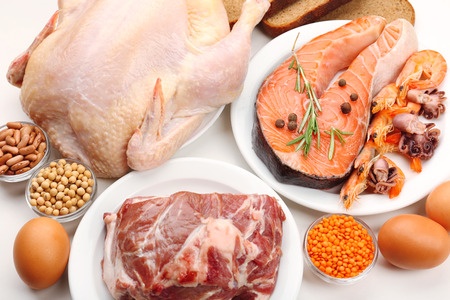
Introduction On Proteins For People
Protein is the main source of amino acids. Here we describe some of the top food sources in some detail. The food groups supplying all amino acids are:-
- Meat
- Poultry
- Fish
- Dairy foods
- Eggs
- Legumes (peas, beans)
The amino acids are the building blocks of proteins and also provide metabolites for energy production.
Protein is essentially used for growth of the human body, especially organs and tissues, cells and enzyme formation. It is also needed for repair and maintenance of cells and tissues, and for generating energy when broken down to its constituent parts.
Amino acids are classified into three groups:
- Essential amino acids
- Nonessential amino acids
- Conditional amino acids
The essential amino acids, nine in total are those that cannot be synthesised by the human body (as in ‘de novo’ synthesis) and must be taken in as food. They are the following:-isoleucine, leucine, valine, lysine, methionine, phenylalanine, tryptophan and histidine. Histidine is essential for children but not for adults but this aspect is still debated upon, although it is best for simple nutrition to regard it as being wholly essential.
Protein complementation is a term used to describe the combining of two sources of protein to obtain the essential amino acids.
The nonessential amino acids are ones that can be synthesised by the body and are alanine, asparagine, aspartic acid, and glutamic acid.
The conditional amino acids are usually not essential, except in times of illness and stress. These are arginine, cysteine, glutamine, tyrosine, glycine, ornithine, proline, and serine.
The Biological Value Of Proteins – LBV Versus HBV
Food protein sources are assigned a biological value, which is an indication of how closely the type and content of amino acids in proteins matches the human body’s protein requirement.
Protein food sources are often described as either LBV or HBV. These acronyms means lower biological value (LBV) as opposed to higher biological value (HBV). LBV protein sources are ones that do not have all the essential amino acids, compared to the HBV proteins sources which are usually rich in all the essential types. Meats are HBV whilst legumes fall into the LBV category.
We should be mindful of the fact that many protein foods contain fat which is healthy in its own right and we should not be fearful of this fact.
Eggs
- Eggs are exceptionally nutritious and contain probably all the micronutrients we need.
They contain 12.6g of protein per 100g of unshelled egg (1).
| Amount of protein:- | 18.9g per 3-egg serving |
| Protein Density: | 35.2% of calories |
Eggs are nutrient-dense for protein but are also exceptional for their high fat content too. They are great sources of vitamins A, B and D and minerals such as selenium and phosphorous. They used to be thought of as unhealthy because of their high cholesterol content but dietary guidelines no longer consider dietary cholesterol as ‘a nutrient of concern’ according to US dietary nutrition web-sites. One review of randomized controlled trials involving heart health in type-2 diabetics has revealed a key finding showing that up to 12 eggs per week “has no adverse effect on cardiovascular risk factors” (Richard et al., 2017).
Canned Tuna
- Tuna from all sources are great sources of protein but canned tuna is probably the best even though a tuna steak might be more appealing to fine diners.
| Amount of protein:- | 35.5g in a 5oz. can |
| Protein Density: | 87.3% of calories |
Canned tuna is on average 25.5g of protein per 100g of tuna meat (3). Tuna is not a fatty fish ‘per se’ but is a good source of fatty acids such as omega-3 fatty acids and fat soluble vitamins such as A,D, E, and K. Canned tuna is relatively free of fat which means it is not as nutritionally complete as an egg however it is 90 percent protein from a calorific or energy point to view.
From a supply chain perspective it is an ambient stored product and so does not require any refrigeration, however once the can is opened it must be stored at chill temperature.
Beef
Beef is a highly valuable as a source of protein but we consider those cuts which are 85 percent lean.
| Amount of Protein: | 36.5g per 5oz serving |
| Protein Density: | 43.2% of calories |
Beef is nutrient dense but its protein density depends on it fat content. Generally, a steak offers approximately 25.9g protein per 100g (4). the leaner the cut the better the quality and quantity of the protein. The protein density of beef very much depends on the fat content.
Beef is a good source of vitamins and minerals, and creatine which is used by athletes as a supplement for improving muscle strength and endurance (Kreider et al., 2017).
While there’s nothing to fear about animal fat, the protein content increases at the leaner end of the scale.
In addition to being high in protein, beef is incredibly rich in minerals and provides several other beneficial compounds for our health.
Shrimp
| Amount of protein:- | 20.3g in 100g |
| Protein Density: |
Reference
Trumbo, P., Schlicker, S., Yates, A.A., Poos, M. (2002) Food and Nutrition Board of the Institute of Medicine, The National Academies. Dietary reference intakes for energy, carbohydrate, fiber, fat, fatty acids, cholesterol, protein and amino acids. J. Am. Diet Assoc. 102(11) pp. 1621-1630

Leave a Reply